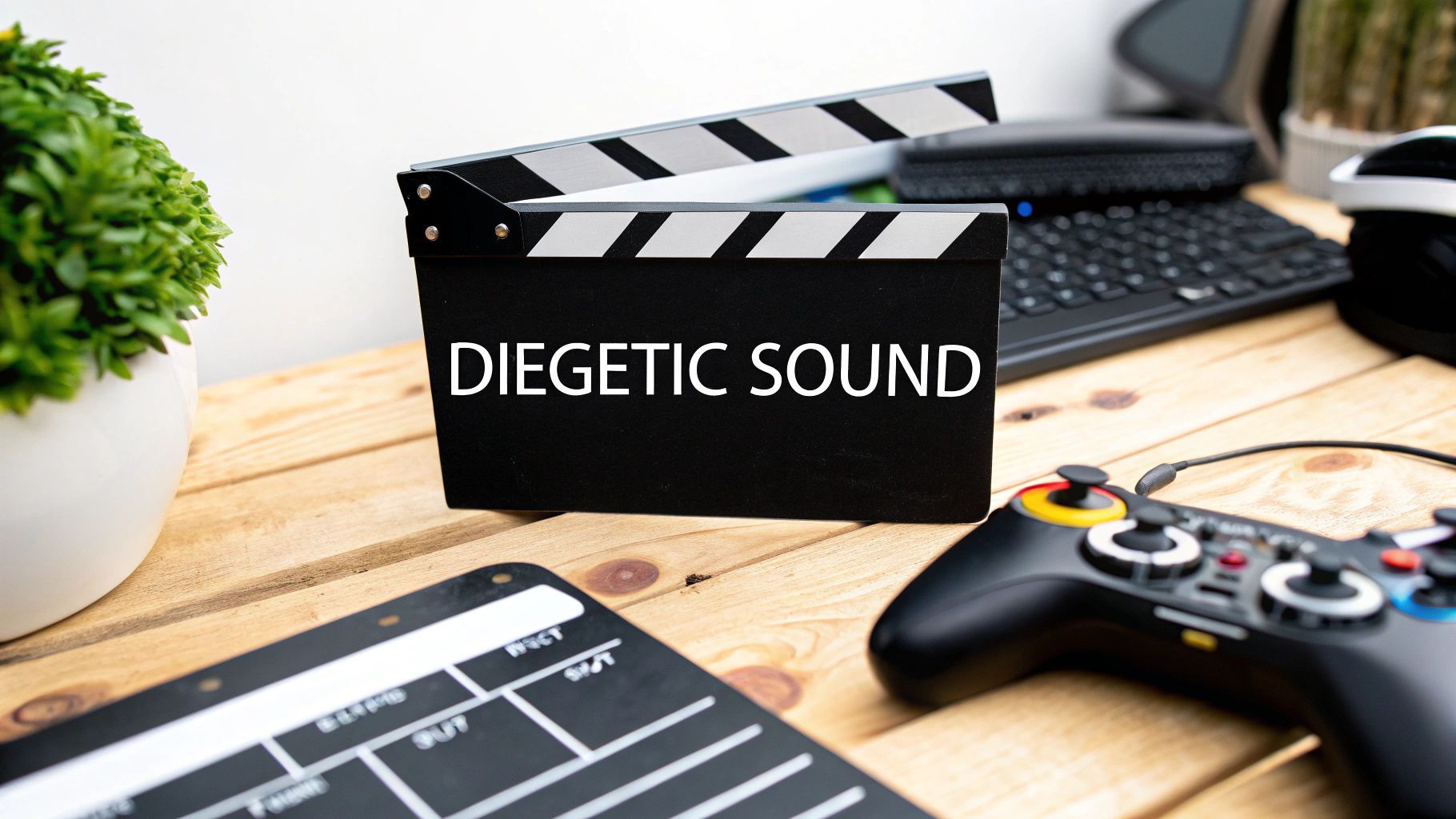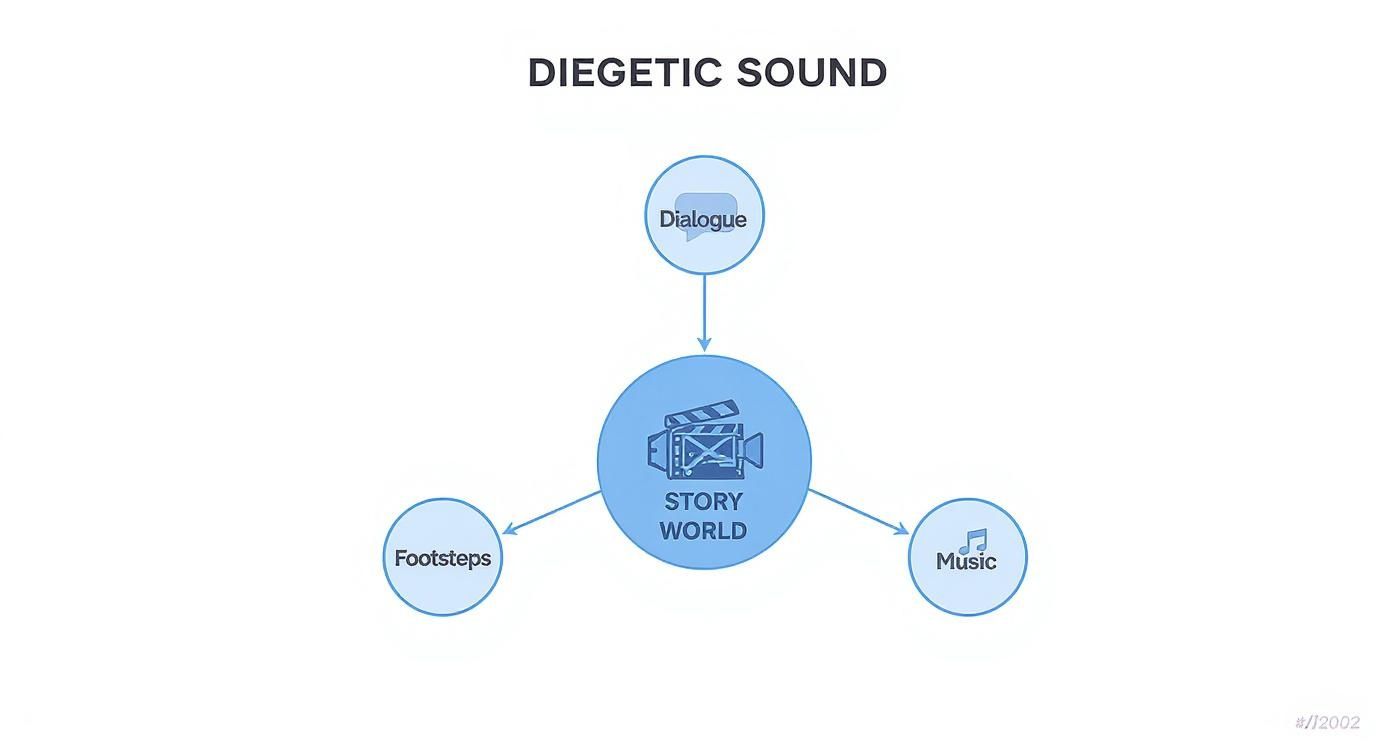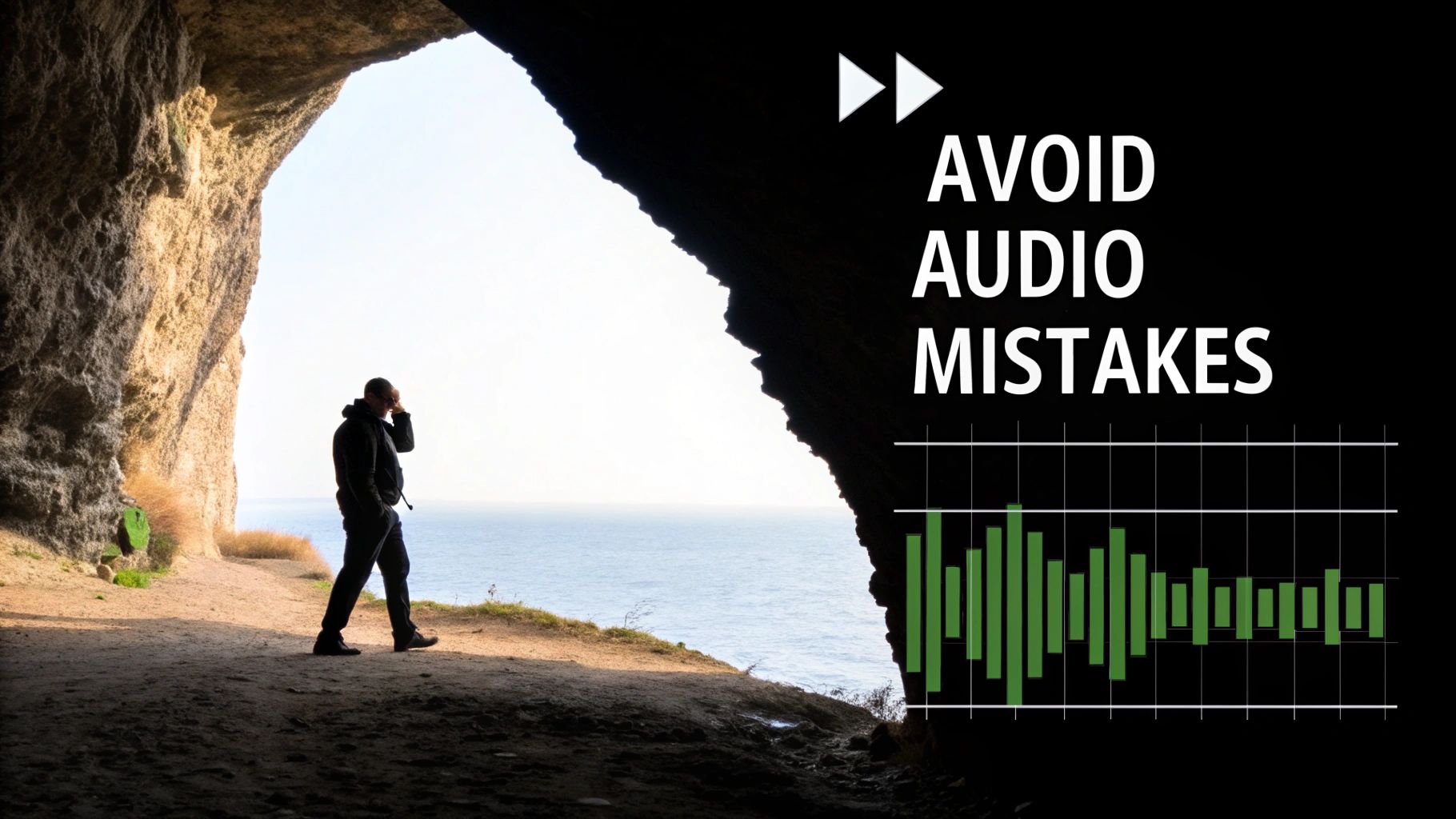
Let's get right to it: diegetic sound is any sound that has a source inside the story's world. It's the audio reality the characters live in. If they can hear it, it's diegetic. This covers everything from the words they speak to the quiet buzz of a fluorescent light overhead.
Picture a scene in a busy coffee shop. You hear the clatter of ceramic mugs, the hiss of the espresso machine, the murmur of conversations, and a barista calling out an order. All of that is diegetic sound. It’s what makes the environment feel real because the characters in that coffee shop are hearing the exact same things you are.
The term itself comes from the Greek word diegesis, which means "narration" or "storytelling." It’s a core building block for creating an immersive world. In film, TV, and games, sound designers spend most of their time on these sounds—in fact, for many films, 70-80% of the entire sound design is made up of diegetic elements. They’re that important for pulling the audience into the story. For a deeper dive, StudioBinder has a great guide on what diegetic sound is.
So, what kinds of sounds are we actually talking about? To really get a handle on diegetic sound, it helps to think about the different layers that make a scene's audio feel authentic and alive. Without these, even the most visually stunning scene would feel hollow and disconnected.
Here are the usual suspects:
The ultimate test is simple: Could a character in the scene realistically hear this sound? If the answer is yes, it's diegetic. This is the sonic glue that holds the world of your story together.
Getting this right is what separates a good story from a great one. When the soundscape feels authentic, the audience isn't just watching anymore—they're right there with the characters, feeling the tension of a creaking floorboard or the energy of a live concert.
Every story operates in two separate sonic universes at the same time. One is the world the characters live in, and the other is a private layer just for the audience. The line between these two is the key to understanding what diegetic sound is all about.
Let's break it down with a simple scene. Imagine a character staring out a window as rain starts to fall. They can hear the soft pitter-patter of the raindrops hitting the glass. That sound is real for them; it exists inside their world. That’s diegetic sound.
But what if, as they’re watching the rain, a sad piano melody begins to play, underscoring their lonely mood? The character can't hear that music. It’s a layer added specifically for us, the audience, to guide our emotional reaction. That’s non-diegetic sound.
This diagram helps visualize what belongs inside the story’s world—the sounds the characters themselves can actually hear.

As you can see, things like character dialogue, footsteps on the pavement, or music from a car radio are all part of the direct, shared experience within the narrative.
Think of non-diegetic sound as the director's secret whisper to the audience. It’s a powerful tool for adding emotional context that the characters are completely oblivious to. It tells you how to feel without having to spell it out on screen.
Some of the most common non-diegetic elements are:
Non-diegetic sound is the ultimate narrative shortcut. It bypasses the story’s internal logic to speak directly to the audience, shaping our perception and guiding our interpretation of the events unfolding.
Now, here’s where things get really interesting. Sometimes, sound can actually move between these two worlds in a move we call trans-diegetic sound.
Picture this: a character is lost in thought, and we start to hear a faint song playing in the background as a non-diegetic score, representing a tune stuck in their head. Then, the character walks into a café, and that exact same song is playing on the radio. The sound just crossed over. It went from being an internal, audience-only cue to a real, tangible sound in the character's environment.
It’s a clever and powerful technique that links a character’s inner thoughts with the physical world around them. Understanding this distinction—and the creative ways sound designers can bridge the gap—is the first step to truly appreciating the complex and beautiful dance of sound in storytelling.
Diegetic sound is so much more than just a technical term—it's one of the most powerful tools a storyteller has. When it’s done right, what could have been simple background noise becomes a core part of the narrative. It guides the audience’s attention, manipulates emotions, and can even control the entire pace of a scene.
Think about it this way: diegetic sound puts you directly into the characters' shoes by connecting you to their sensory reality. If a character is startled by a door slamming shut, you jump too. If they feel a sense of calm listening to a crackling fireplace, you feel that same comfort. It’s this shared experience that builds true immersion.
Filmmaker Edgar Wright is a master of this craft. He doesn't just use diegetic sound for realism; he weaves it into the very fabric of his stories. His film Baby Driver is a perfect example, where the entire rhythm of the movie is dictated by the music the main character, Baby, listens to on his headphones.
The action isn't just set to a cool soundtrack—it's meticulously choreographed to it. Gunshots pop on the beat, cars screech in time with the melody, and every punch lands in sync with the diegetic music from Baby's iPod. This isn't just a gimmick; it’s brilliant storytelling that achieves several things at once:
In video games, diegetic sound often evolves from a storytelling tool into a crucial gameplay mechanic. Naughty Dog’s The Last of Us is a textbook case of how in-world audio cues can mean the difference between life and death. That terrifying, signature click of an Infected isn't just there to create a spooky atmosphere—it's critical intel.
Diegetic sound stops being just a narrative element and becomes a direct interface between the player and the game world. Hearing an enemy's footsteps isn't just scary; it's a signal to hide, aim, or run.
This intense focus on in-world audio is a conscious design choice. In many story-heavy games, a staggering 60-70% of all sounds are diegetic, from the clatter of a reloading weapon to the rustling of leaves. This high ratio is what makes the world feel believable and responsive. The same principle holds true in other media; scripted TV dramas, for instance, often feature diegetic dialogue for over 90% of spoken content.
Getting these sounds right is absolutely essential. To dig deeper into how audio builds these high-stakes digital worlds, take a look at our complete guide on sound design for games.
Ultimately, whether you're watching a film or playing a game, diegetic sound is the invisible force that pulls you in deeper, transforming you from a passive observer into an active participant in the story.

Knowing the theory is one thing, but actually building a believable sonic world from the ground up? That’s a whole different ball game. It takes a careful mix of on-set recording, creative post-production work, and some serious mixing chops to make every sound feel like it truly belongs in the scene.
Your foundation is almost always built on location. Getting clean dialogue and capturing the ambient room tone is non-negotiable. That room tone—the subtle, unique hum of a supposedly quiet space—becomes your sonic canvas. It's the glue that holds everything together and prevents jarring silence between edits.
Of course, many of the most important sounds aren't captured on set. They’re added later, and this is where the real artistry of sound design comes into play.
Once you get into post-production, the main job is to fill the world with sounds that feel completely authentic to what’s happening on screen. This usually means drawing from a few different sources.
One of the most powerful tools in your arsenal is Foley, which is the art of performing and recording sound effects perfectly in sync with the picture. It’s the secret behind so many sounds we take for granted, like the swoosh of a jacket or the crunch of leaves underfoot. If you want to dive deeper into this fascinating craft, you can learn more about what Foley sound is and how it breathes life into a scene.
Besides Foley, you’ve got a couple of other go-to options:
Layering these sounds is absolutely crucial. In a typical film, diegetic sounds like footsteps, props, and ambient noise can easily account for 40-50% of the entire audio track. It’s no surprise that modern workflows often dedicate up to 75% of post-production time to getting these sounds perfectly placed and mixed.
Just dropping a sound effect into your timeline isn’t enough. You have to make it feel like it exists in the three-dimensional space of the scene. That’s where mixing comes in—it’s all about manipulating audio to convince the audience's ears.
A sound's believability comes not just from what it is, but where it is. Proper mixing places the sound within the scene, creating a sonic geography that matches the visual one.
Here are the key techniques you'll use:
Mastering these techniques will help you build a diegetic soundscape that doesn't just sound real but feels completely immersive. For more great ideas to level up your audio, checking out some general tips and tricks for making video sound can give you an extra edge.

You can have the most breathtaking visuals in the world, but a sloppy soundscape will shatter the illusion in a heartbeat. When the diegetic sound doesn't line up with the reality of the scene, it creates an invisible crack in the world you’ve built. That tiny fissure is all it takes to pull your audience right out of the experience.
Spotting and fixing these immersion-breaking moments is one of the most important jobs of a sound designer. The good news? Most of these mistakes are pretty common and, once you know what to listen for, surprisingly easy to fix.
Let's walk through the usual suspects and how to handle them.
One of the most jarring errors is when the sound of a space just doesn't match what you're seeing. This happens all the time with dialogue. You record clean audio in a dead-quiet studio booth and then drop it into a scene set in a cavernous warehouse or a tiny, tiled bathroom. The result is instantly noticeable.
The goal is to convincingly "place" the audio inside the visual environment. Every room, forest, and hallway has its own unique sonic fingerprint. Your diegetic sound has to match it.
This one is a little more subtle but just as damaging. It happens when the sound effect you choose doesn't quite match the object or action making the noise on screen. Our brains are incredibly skilled at picking up on these tiny inconsistencies, even if we don't consciously register them.
Keeping your audience immersed is a goal shared across many different fields. If you're interested in how deep engagement is achieved in other areas, you can explore the principles of immersive learning. By sidestepping these common audio pitfalls, you ensure your sonic world is a seamless extension of your visual one.
We've covered a lot of ground, from what diegetic sound is to how you can start using it to build a more compelling world. If there’s one thing to take away from all this, it's that diegetic sound is the sonic glue holding your story's reality together. It's not just background noise; it's a fundamental layer of storytelling, as important as the visuals or the script.
The next step is simple: start listening. Pay attention to the soundscape of your own life, and then listen critically to the films, games, and podcasts you love. Notice how sound anchors you in a scene and makes you feel like you're truly there.
Your challenge, then, is to take that awareness into your own work. No matter what you're creating, think about how you can use sound to build a world that your audience doesn't just watch or hear, but feels on a gut level.
By focusing on the sounds that exist within the story, you transform passive viewers into active participants, making your narrative world feel tangible, authentic, and unforgettable. This is the true power of great sound design.
Once you’ve mastered the basics, you can start digging into more advanced concepts. Understanding things like what spatial audio is will open up a whole new dimension, allowing you to build truly immersive, three-dimensional audio environments.
Once you start thinking in terms of diegetic vs. non-diegetic sound, you'll find a few tricky questions always seem to come up. It's one thing to know the definition, but it's another to apply it to real-world scenarios.
Let's walk through some of the most common head-scratchers to make sure you've got a rock-solid understanding of what diegetic sound is.
Yes, 100%. This is a big one, but the answer is simple: if the music has a source inside the story's world, it's diegetic. It's a fantastic tool for pulling the audience deeper into the scene and even telling us something about the characters.
Just think about it:
In all these cases, the characters can hear the music right along with the audience. It's part of their world, which is the total opposite of a non-diegetic score that only the audience hears.
Almost always. When characters talk to each other, that's the purest form of diegetic sound you can get. It’s the audio foundation of storytelling.
But there’s one major exception every creator should know:
An internal monologue or a character's voiceover sharing their private thoughts is non-diegetic. Why? Because no one else in the scene can hear it. It's a direct line to the audience, breaking the rules of the story's reality.
This is a powerful technique for giving the audience a secret look inside a character’s head.
This is a great question that gets to the heart of theory vs. practice. They aren't opposites; one is actually a method for creating the other.
Here’s the breakdown:
Diegetic sound is the concept. It's any sound that belongs in the world of the story, from footsteps to a closing door.
Foley, on the other hand, is the craft of creating those sounds. It's the practical art of a Foley artist in a studio, crunching cornstarch to mimic footsteps in snow or snapping celery to sound like breaking bones, all perfectly timed to the picture to build a believable diegetic world.
Ready to stop hunting for the perfect sound effect and just make it? SFX Engine uses AI to generate unique, high-quality, and royalty-free diegetic sounds from a simple text prompt. Find the perfect audio for your project.